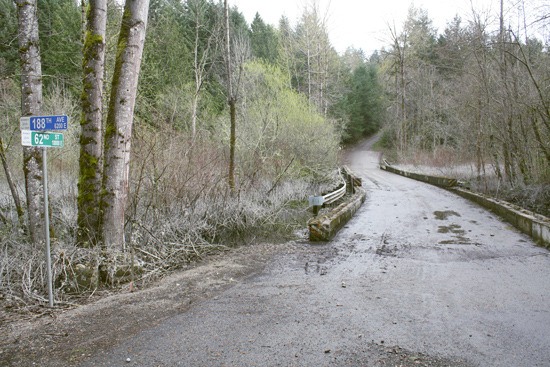Bonney Lake is packing up the pump.
Last Thursday, the city ended the month-long process of pumping water off several streets that started flooding last winter.
Bonney Lake residents started noticing water on 185th street, 187th street and the intersection of 188th and 62nd was not going into the ground last December and January. In previous years, water would come close to covering the road, but flooding on this level hasn’t occurred since 1996.
By the time the city intervened Feb. 17, vehicle access to several homes was impossible. Residents were starting to feel the effects of being cut off from the rest of the city as mail and garbage service weren’t able to reach their homes. One resident even had to buy a boat to get from his home to where his car was parked on the other side of the flooded area.
The city spent almost five weeks pumping water out of the area into Lake Tapps, mostly on a 24 hour a day schedule, pausing only for the weekends.
The cost of the project came to around $50,000, excluding overhead, according to City Administrator Don Morrison.
Final measurements confirm more than 4.5 feet of water was pumped out of what the city has named “The Pothole”, a 17.5-acre area inside FEMA flood zone established in 1980. The city estimated nearly 23 million gallons of water was pumped into Lake Tapps.
And while all the public and private roads were clear for vehicle and foot access since last week, pumping the remaining water out of the Pot Hole becomes a problem because much of the basin is private land.
Problems with private land
In a letter sent out to Bonney Lake residents affected by the flood, the city said it is unable to continue pumping water out of the Pot Hole once the public streets are cleared, since the end of 62nd street is privately owned and the Pot Hole is owned by the property owners whose lots compose it.
“The state Constitution prohibits us from lending credit, meaning we can’t use public funds, to benefit private property unless it’s for the care of the poor or infirm,” Morrison said in a phone interview March 23. “A public street can fail if water sits on it too long, so in that sense we are justified to pump the water down to get it below the base of the road so it can dry out and function. But we really don’t have a duty or even the right to keep pumping it until all the private roads are dry.”
And if the Pot Hole fills up with water again before the rainy season ends, the city isn’t sure it would be able to bring the pump back out.
“We’ve spent close to $50,000 dollars, and that was unbudgeted in the storm water fund, and that benefits just a few homeowners,” Morrison said. “It would be a tough call for the council to go out and do that again without any contribution from the benefiting parties.”
The city did improve the private bridge connecting 62nd St. to 188th St. after the Pot Hole flooded in 1996, but according to Morrison, the city did not have the time or money to do an official boundary line survey in the area at the time and the improvements were “likely an illegal expenditure.”
Cause of the flood
What has caused the Pot Hole to flood remains a mystery to both the city and residents, although several theories have been voiced.
The Pot Hole has flooded only one other time in the last 20 years, but the circumstances were very different.
According to City Engineer John Woodcock, the Pot Hole flooded in 1996 when a Pineapple Express, a cold front followed by warm rain, came through the city. Snow was dumped into the Pot Hole and the warm rain that followed melted it, resulting in too much water for the ground to absorb quickly.
This year, the problem is water not going back into the ground, not that there was too much water getting dumped in the area, Woodcock said.
The city first pointed to the levels of rain the area received this year as a cause.
NOAA data from the Tacoma Station revealed around 33.8 inches of water fell in the area between October 2015 and January 2016, making this last rainy season the second wettest in 20 years.
The McMillin Reservoir in South Hill confirmed its measurements of 32.09 inches, although NOAA data collection at the McMillin Reservoir recorded only 17.31 inches of rain fell, a disparity Tacoma Public Utilities was unable to explain.
But even though it was the second wettest season, comparable rainfall has hit Bonney Lake before without the Pot Hole filling, Woodcock said.
Another theory is Lake Tapps remained at a higher level (535 feet) over the winter than usual, which could have raised the water table underground.
But Cascade Water Alliance Communication Director Elaine Kraft said this theory doesn’t hold water, because the lake has been drawn down to only 535 feet many times over the past years, even before Cascade bought the lake from PSE in 2009.
This points to the lake has little to no effect on the flooding issue in the Pot Hole, Kraft confirmed in an email interview.
Other theories include additional natural springs feeding water into the Pot Hole (there are several springs resident’s have been aware of for years) to additional run-off being fed into the basin because of development in the area.
Although Woodcock mentioned he would like to run water infiltration tests in the summer months, Morrison said he doesn’t think the city is going to commission any studies in the area, but the discussion hasn’t reached the city council.


